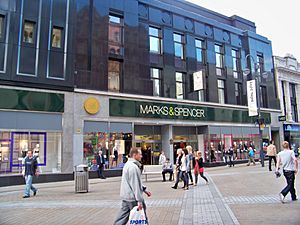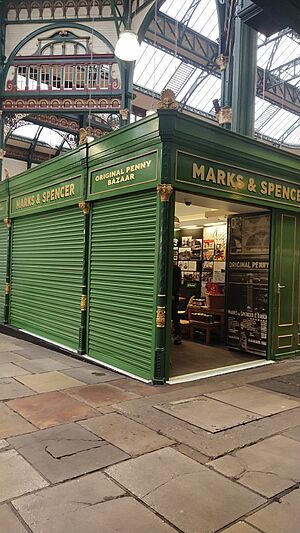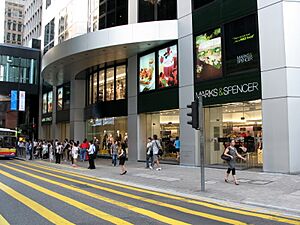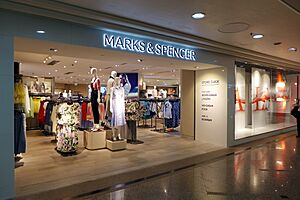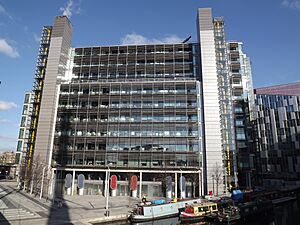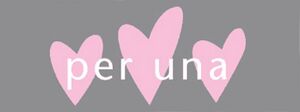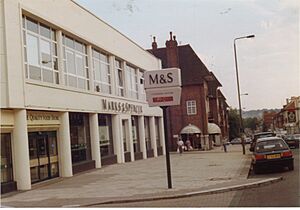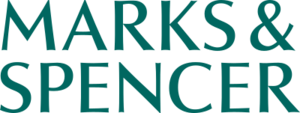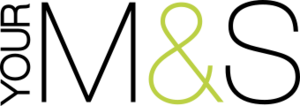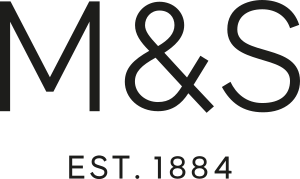- This page was last modified on 17 October 2025, at 10:18. Suggest an edit.
Marks & Spencer facts for kids
"M&S" redirects here. For other uses, see M&S (disambiguation).
 |
|
| Public limited company | |
| Traded as | LSE: MKS FTSE 100 Component |
| Industry | Retail |
| Founded | 1884 Leeds, West Riding of Yorkshire, England |
| Founders |
|
| Headquarters | London |
|
Number of locations
|
1,463 (2019) |
|
Area served
|
Worldwide |
|
Key people
|
|
| Brands |
|
| Revenue | |
|
Operating income
|
|
|
Number of employees
|
64,000 (2025) |
| Parent | Marks and Spencer Group P.L.C. (2016–present) |
Marks and Spencer plc, often called M&S or simply Marks, is a large British company. It sells clothing, beauty products, home items, and food. M&S is based in London, England. You can find its shares on the London Stock Exchange.
M&S started in 1884 in Leeds. It was founded by Michael Marks and Thomas Spencer. The company is famous for its high-quality food and drinks. M&S also offers online food delivery through a partnership with Ocado. In 1980, M&S was the first British supermarket to sell packaged sandwiches.
In 1998, M&S made a profit of over £1 billion before taxes. This was a first for a British retailer. However, the company then faced a sudden difficult period. In 2008, M&S started selling other well-known brands like Kellogg's corn flakes. In the early 2000s, clothing sales went down, but food sales grew. M&S also stopped using its old "St. Michael" brand for most products.
M&S announced plans to close many stores to improve its business. By 2022, over 100 stores were set to close. In 2020, about 7,000 jobs were cut due to the COVID-19 pandemic. In 2021, M&S planned to close another 30 shops over the next 10 years. The company shared in 2024 that it aims to have 180 large stores and 420 food-only stores in the UK. This is because older stores cost more to run.
Contents
The Story of M&S: How It Began
Starting a Business: The Penny Bazaar
The company began with a partnership between two people. One was Michael Marks, who came from Poland to Leeds, England. The other was Thomas Spencer, a cashier from Skipton in North Yorkshire. In 1884, Michael Marks borrowed £5. He used this money to open a "penny bazaar" stall. This was at Kirkgate Market in Leeds.
Thomas Spencer helped Marks learn English. In 1894, Marks got a permanent stall in the market. He then asked Spencer to become his business partner.
In 1901, Marks moved his business to Birkenhead and joined with Spencer's business. They opened a penny bazaar there. The company later moved its first Leeds stall to Manchester. They also opened many market stalls across North West England. Spencer passed away in 1905, and Marks in 1907. Michael Marks' son, Simon, became the chairman in 1916. Under Simon Marks, the company grew into a large retail business.
Growing Across the UK

A model of a historic M&S store from the 1930s at Bekonscot model village, UK
M&S started selling clothes in 1926 and food in 1931. For many years, M&S was known for selling almost all British-made goods. They worked closely with British manufacturers. Clothes were sold under the "St Michael" brand, named after Michael Marks. This brand started in 1928 and was used for food by 1941. M&S also had a very generous return policy. Customers could return unwanted items for a full refund with a receipt, no matter how long ago they bought them. This was very unusual at the time.
During Second World War in 1941, M&S staff raised £5,000. This money helped pay for a Supermarine Spitfire fighter plane. It was named The Marksman. By 1950, nearly all products were sold under the "St Michael" label. Simon Marks, Michael Marks' son, passed away in 1964. Israel Sieff, Michael Marks' son-in-law, then became chairman. M&S began to expand slowly into other countries in 1974. They opened stores in Europe in 1975 and in Ireland in 1979.
The company always focused on quality. In 1948, they created a Food Technology department. Staff in their cafeterias received hygiene training by the mid-1950s. M&S also had a reputation for fair prices. Their slogan in 1953 was: "The customer is always and completely right!" This showed their strong focus on customer service.
M&S started selling Christmas cakes and Christmas puddings in 1958. They hired a food expert, Nat Goldberg, to improve their cakes. Food labels were also improved, and "sell by dates" were added between 1970 and 1972. In 1959, smoking was banned in all M&S shops for safety.
Expanding Around the World
M&S expanded into Canada in 1973. At one point, they had 47 stores there. However, the stores struggled to attract new customers. The Canadian shops were smaller and had fewer items than the British ones. In 1999, the last 38 shops in Canada were closed.
Expansion into France began in 1975 with stores in Paris and Lyon. More stores opened in other French and Belgian cities in the 1980s. While Paris stores were popular, the European operations overall did not do as well. Many stores were sold in 2001. In 2011, M&S decided to reopen stores in France that sold both food and clothing. They also opened several food-only stores in Paris.
In 1988, Marks & Spencer bought Brooks Brothers, an American clothing company. They also bought Kings Food Markets, a US food chain. In the early 1980s, M&S was the first British supermarket to sell packaged sandwiches. This idea became very popular, and other supermarkets followed. By 1990, the British sandwich industry was worth £1 billion.
M&S in the 21st Century
Changes and Challenges

An M&S shop in Inverness in 1998
M&S's profits reached their highest point in 1997–1998. However, profits then dropped sharply. One reason was that M&S did not accept other credit cards until 2001, only its own. This made some customers unhappy. By 2001, profits had fallen significantly.
In 2002, M&S made changes to improve. They started accepting other credit cards. They also launched a new clothing line called "Per Una". These changes helped profits recover. In 2004, another company tried to buy M&S. M&S announced a plan to recover, which included selling its financial services business. The takeover bid was then withdrawn.
In 2007, M&S opened its largest store outside the UK in Dubai Festival City. In 2008, M&S opened its first store in mainland China, in Shanghai.
Making Changes to Stores
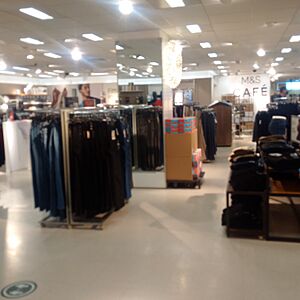
The inside of an M&S store in Wakefield, West Yorkshire in 2020
In 2009, M&S closed 22 smaller food stores to save money. More stores were closed in 2010 due to low sales. These closures sometimes led to protests from local communities.
In 2010, M&S announced plans to improve its brand image. They planned to invest more money in their stores and online presence. They also stopped selling some fashion brands and electrical products. M&S launched a new marketing slogan, 'Only at M&S'. They also updated their website.
In 2013, M&S launched a new clothing range called Best of British. They also updated their Per Una and Indigo ranges. The company aimed to bring "quality and style back".
In 2016, Steve Rowe became the new CEO. In 2018, Stuart Machin became the managing director for the food business. In 2024, M&S started a new service for clothing repairs and alterations. This was in partnership with the Sojo company.
In 2018, TV presenter Holly Willoughby became a brand ambassador for M&S. The company also introduced a hijab in its school uniform section in late 2018.
Store Closures and Redevelopment
M&S continued to close stores that were not making enough money. In 2018, managers confirmed that 14 more shops would close. Another 86 were being reviewed. This meant over 100 stores would close by 2022. In 2021, M&S announced plans to close another 30 shops over the next 10 years. By September 2021, half of the French stores had closed due to issues from Brexit.
In 2021, M&S planned to rebuild its largest store at Oxford Street in London. The plan was to replace it with a 10-story building. This would have shops on the lower floors and offices above. Despite protests, the plans were approved by the local council. However, in 2022, a government minister blocked the plans. He ordered a public inquiry. The inquiry looked at how the project would affect historic buildings and the environment.
In July 2023, the minister rejected the plans. He said it would harm heritage and the environment. M&S disagreed and challenged the decision in court. In March 2024, a court judge overturned the minister's decision. In December 2024, the new minister approved the store's demolition. She said it would help create jobs and improve London's West End.
New Leaders and Animal Welfare
In March 2022, Steve Rowe stepped down as CEO. Stuart Machin became the new CEO, with Katie Bickerstaffe as co-CEO.
M&S takes animal welfare seriously. They work with the RSPCA Assured scheme. This means animals in their supply chain should be raised to high welfare standards. However, there have been times when hidden cameras showed animal mistreatment at some farms. When this happened, M&S investigated and suspended the farms from their supply chain. They stated that they have rigorous standards for their suppliers. M&S has also stopped the practice of eyestalk ablation for shrimps in its supply chain.
New Purchases and Partnerships
In July 2022, M&S bought the logistics company Gist Limited. In November 2022, M&S acquired technology from a fashion company called Thread. They hired some of Thread's staff. The goal was to add personalized recommendations to the M&S website.
M&S has also formed partnerships to improve its business. In 2018, they partnered with Microsoft to use artificial intelligence (AI) for customer experience. In 2021, M&S worked with Namogoo to improve online shopping. In 2024, M&S expanded its partnership with First Insight to use AI for better insights. In January 2025, M&S renewed its partnership with Retail Insight. This helps them reduce food waste using AI.
Cyber Incident in 2025
In April 2025, M&S faced problems with contactless payments and online orders. This happened over the Easter weekend. The company confirmed it was dealing with a cyber incident. On April 25, M&S stopped taking orders on its website. This was believed to be a type of cyber attack called ransomware. The attack happened through a third-party company that M&S worked with.
In May 2025, it was reported that M&S was preparing to claim on its cyber insurance policy. This would help cover losses from the incident. The incident reduced the company's market value by over £1 billion. By June 10, 2025, the company had restored online ordering on its website.
How M&S is Organized
Main Offices
M&S's main office moved to Waterside House in Paddington Basin, London, in 2004. Before that, it was at Michael House in Baker Street, London, since 1957.
Besides London, M&S has other offices in the UK. These include Stockley Park for IT services, Salford Quays for human resources and finance, and Chester for M&S Bank and customer services. The company also has offices in many countries around the world. These offices help with sourcing products.
Financial Information
M&S reports its financial results each year. The table below shows how the company has performed over time. It includes turnover (total sales), profit before tax, net profit, and earnings per share.
| Year ended | Turnover (£ M) | Profit before tax (£ M) | Net profit (£ M) | Basic eps (p) |
|---|---|---|---|---|
| 29 March 2025 | 13,816.8 | 511.8 | 291.9 | 14.6 |
| 30 March 2024 | 13,040.1 | 672.5 | 425.2 | 21.9 |
| 1 April 2023 | 11,931.3 | 475.7 | 364.5 | 18.5 |
| 2 April 2022 | 10,885.1 | 391.7 | 309.0 | 15.7 |
| 3 April 2021 | 9,155.7 | (209.4) | (201.2) | (10.1) |
| 28 March 2020 | 10,181.9 | 403.1 | 27.4 | 1.3 |
| 30 March 2019 | 10,377.3 | 523.2 | 37.3 | 2.1 |
| 31 March 2018 | 10,698.2 | 580.9 | 29.1 | 1.6 |
| 1 April 2017 | 10,622.0 | 613.8 | 115.7 | 7.2 |
| 2 April 2016 | 10,555.4 | 488.8 | 404.4 | 24.9 |
| 28 March 2015 | 10,311.4 | 600.0 | 481.7 | 29.7 |
| 29 March 2014 | 10,309.7 | 580.4 | 506.0 | 32.5 |
| 30 March 2013 | 10,026.8 | 564.3 | 458.0 | 29.2 |
| 31 March 2012 | 9,934.3 | 658.0 | 489.6 | 32.5 |
| 2 April 2011 | 9,740.3 | 780.6 | 598.6 | 38.8 |
| 3 April 2010 | 9,536.6 | 702.7 | 523.0 | 33.5 |
| 28 March 2009 | 9,062.1 | 706.2 | 506.8 | 32.3 |
| 29 March 2008 | 9,022.0 | 1,129.1 | 821.0 | 49.2 |
| 31 March 2007 | 8,588.1 | 936.7 | 659.9 | 39.1 |
| 1 April 2006 | 7,797.7 | 745.7 | 520.6 | 36.4 |
| 2 April 2005 | 7,490.5 | 505.1 | 355.0 | 29.1 |
| 3 April 2004 | 8,301.5 | 781.6 | 452.3 | 24.2 |
| 29 March 2003 | 8,019.1 | 677.5 | 480.5 | 20.7 |
| 30 March 2002 | 8,135.4 | 335.9 | 153.0 | 5.4 |
| 31 March 2001 | 8,075.7 | 145.5 | 2.8 | 0.0 |
| 1 April 2000 | 8,195.5 | 417.5 | 258.7 | 9.0 |
| 31 March 1999 | 8,224.0 | 546.1 | 372.1 | 13.0 |
| 31 March 1998 | 8,243.3 | 1,155.0 | 815.9 | 28.6 |
| 31 March 1997 | 7,841.9 | 1,129.1 | 746.6 | 26.7 |
| 31 March 1996 | 7,233.7 | 965.8 | 652.6 | 455.8 |
Caring for the Planet and People
"Look Behind the Label" Campaign
In 2006, M&S started the Look Behind the Label campaign. This campaign showed customers how M&S produced and sourced its products ethically. It highlighted things like Fairtrade products and sustainable fishing. All coffee and tea sold in M&S stores is now Fairtrade. They also offer clothing made from Fairtrade cotton.
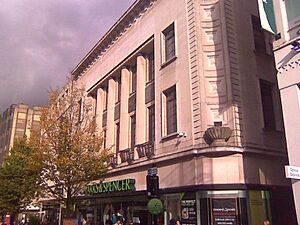
M&S store on Birmingham High Street (relocated in 2023)
In 2007, M&S launched "Plan A". This was a big plan to make the business much more environmentally friendly within five years. It aimed to address social and environmental challenges. The plan had 100 commitments. These included becoming carbon neutral and sending no waste to landfill. It also aimed to use more sustainable sourcing. M&S wanted to help people in their supply chain and encourage healthier lifestyles.
M&S introduced a reusable hessian bag in 2007. This was to reduce the use of plastic bags. In 2008, they started charging 5p for standard carrier bags for food. Profits from these bags went to charity. M&S also uses wind turbines to generate power for some of its stores. In 2009, the company started buying renewable energy for all its stores and offices in England and Wales. In 2012, M&S won an award for Plan A.
Helping Communities
M&S has supported Breakthrough Breast Cancer by selling charitable clothing. In 2010, a store in Ashbourne raised £2,000 for a local hospital. In 2011, M&S partnered with Oxfam for a clothes recycling initiative.
In 2015, M&S teamed up with Neighbourly. This partnership helps them give unsold food and other items to charities and community groups. In 2020, M&S donated £100,000 to the Neighbourly Community Fund. They also donated to the National Emergencies Trust Coronavirus Appeal. This helped communities affected by the COVID-19 pandemic.
Company Leaders
Many people have served as chairman of M&S since it started:
- 1884–1907: Michael Marks
- 1907–1916: William Chapman
- 1916–1964: Simon Marks (Lord Marks)
- 1964–1967: Israel Sieff (Lord Sieff)
- 1967–1972: Edward Sieff
- 1972–1984: Marcus Sieff (Lord Sieff)
- 1984–1991: Derek Rayner (Lord Rayner)
- 1991–1999: Sir Richard Greenbury
- 2000–2004: Luc Vandevelde
- 2004–2006: Paul Myners
- 2006–2009: Lord Burns
- 2009–2011: Sir Stuart Rose
- 2011–2017: Robert Swannell
- 2017–present: Archie Norman
Company History Records
The M&S company archive is kept at the University of Leeds. This archive has permanent displays like a museum. It also hosts special exhibitions.
M&S Stores Around the World
Stores in the UK and Ireland
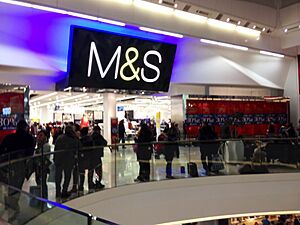
M&S White City in Westfield London (2014), one of the company's largest stores
The biggest M&S store is near Marble Arch, on Oxford Street in London. It has about 16,000 square meters of shopping space. The second largest store is in Cheshire Oaks, Ellesmere Port. The third largest is at the Gemini Retail Park in Warrington. In 1999, M&S opened a large store in Manchester's Exchange Square. This store was rebuilt after a bombing in 1996. The smallest M&S store is a "Penny Bazaar" outlet in the Grainger Market in Newcastle upon Tyne.
M&S has also opened stores in shopping centers outside of town centers. The first was at the MetroCentre in Gateshead in 1986. Another example is the store at the Merry Hill Shopping Centre in Brierley Hill. This store opened in 1990.
Before Christmas 2006, 22 M&S shops were open 24 hours a day. This included stores in Bolton and Newtownabbey, Northern Ireland.
In the Republic of Ireland, M&S has 17 stores and employs 2,000 people. These stores sell both M&S products and Irish brands. In 2021, M&S Ireland began changing its product line due to trade issues after Brexit. They planned to stock more Irish goods.
International Stores
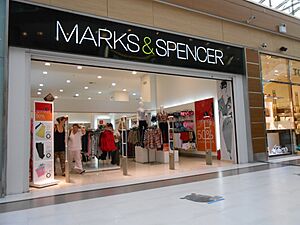
A Marks & Spencer branch in Athens, Greece
M&S reopened its store in Paris in November 2011. In the Philippines, the Rustans Group operates 18 M&S shops. The largest is in Greenbelt Mall. A new store opened in Amsterdam, Netherlands, in 2013. M&S also opened small food stores at BP petrol stations in the Netherlands. There are over 300 M&S stores in about 40 countries outside the UK.
In November 2013, Marks & Spencer announced plans to have about 80 stores in India by 2016. This was part of their goal to become a leading international retailer. They opened a large store in Mumbai. M&S lingerie sales are very popular in India. By May 2014, M&S aimed to open 100 stores in India by 2016.
M&S has faced boycotts from anti-Israel protestors. In 2014, the Marble Arch store was picketed weekly due to the sale of Israeli goods.
In 2016, M&S announced it would close all its stores on the European mainland. However, this did not fully happen. They did close their stores in the Netherlands. Marks & Spencer owns 51 stores in Turkey. Fiba Retail is the company that opens M&S stores in Turkey and Ukraine.
Stores in Hong Kong and Macau were sold in early 2018 to Al-Futtaim Group. In September 2021, M&S confirmed the closure of 11 stores in France. This was due to supply chain issues after Brexit. However, they still operate nine smaller stores near major travel hubs.
Types of M&S Stores
Full-Line Stores
M&S's main stores usually sell clothing, home goods, beauty products, and food. The types of clothes sold depend on the store's location and customers. Some London stores, for example, might not sell the Classic Collection. Many stores also have an M&S Café.
M&S Food Stores
All the St Michael Food hall supermarkets were renamed M&S Foodhall in 2000. They sell groceries, mostly under the Marks & Spencer brand. In 2006, the company started selling a small range of other brands, like Coca-Cola. This was the first time M&S sold brands other than its own.
M&S launched smaller convenience stores called Simply Food in 2001. These mainly sell food, but some larger ones also have a few general items. Many of these are run by other companies. For example, SSP Group runs outlets at train stations and airports. Moto has outlets at motorway service areas. BP petrol stations also have Simply Food offerings.
M&S started using self-checkout tills in food halls in 2002. Self-service checkouts were added to general merchandise sections in 2006.

M&S Simply Food in Banstead, Surrey
In 2015, the Simply Food brand was changed to M&S Foodhall for larger stand-alone stores.
In 2019, M&S announced it would open more supermarket-sized food halls. These would be between 10,000 and 15,000 square feet. They would stock the full food range to attract families doing weekly shops. M&S also lowered prices on over 1,000 popular items to compete with other large supermarkets.

An M&S Food to Go store in Sutton station, Sutton, London
In 2019, M&S combined all its food stores under the M&S Food brand. Stores were updated to look like a fresh market.
Home Stores
In 2007, M&S announced plans for stores dedicated to home furnishings. These have opened in places like Cheltenham and Royal Tunbridge Wells.
Outlet Stores
M&S has outlet stores that sell M&S products at a discount. Most items are at least 30% off the original price. The first outlet store opened in Ashford in 2000. By 2020, there were 25. Many are in retail parks or outlet centers.
Online Shopping
Online food deliveries began with trials in 2017. In 2019, M&S bought 50% of Ocado Retail Ltd. This made M&S Ocado's new retail partner. Since 2020, customers can order food and some clothing items from Ocado's website. In February 2024, it was reported that M&S did not plan to pay a final payment to Ocado. This was because performance targets were not met in 2023.
Other Services from M&S
Besides its main shops, M&S works with other companies to offer more services:
- M&S Bank – This offers credit cards, loans, and other financial services. HSBC UK operates it.
- M&S Travel Money – You can exchange foreign currency in stores or order it online. Eurochange provides this service.
- M&S Opticians – This service is operated by Owl Optical.
M&S Product History
The "St Michael" brand was created by Simon Marks in 1928. It honored his father, Michael Marks, who co-founded the company. By 1950, almost all M&S products used the St Michael brand. The brand was stopped in 2000. However, it returned in a small way as an emblem in 2021.
New fabrics were introduced over the years. Tricell was used from 1957 to the 1970s. Courtelle was launched in 1960. Machine-washable wool appeared in 1972, and Lycra hosiery in 1986.
"Per Una" was launched in 2001. It was a joint project between M&S and Next founder George Davies. The Per Una brand became very successful for M&S. In 2004, M&S bought the brand completely.
In 2004, some brands were removed. These included a menswear brand and a sportswear range. A children's range by David Beckham was also stopped. A version of Per Una for teenagers, "Per Una Due", was also discontinued due to low sales.
In 2008, M&S started selling other well-known brands like Kellogg's corn flakes. After a review in 2011, M&S decided to reduce the number of branded items. They would only sell brands for products they didn't have an M&S alternative for.
In January 2021, Marks & Spencer bought the Jaeger fashion brand. This deal was part of M&S's plan to add new names to its clothing section. The deal did not include Jaeger's stores.
How M&S Advertises
Early 2000s Marketing
When the company faced difficulties in the early 2000s, the St Michael brand was replaced. All M&S products started using the Marks & Spencer name. A new logo was also introduced. This new logo appeared on product packaging, store fronts, and shopping bags. The St Michael name was then used as a "quality guarantee". It appeared on food products and delivery vehicles.
Your M&S Campaign
In 2004, a new marketing director joined M&S. He introduced a new promotional brand called Your M&S. It had its own logo.
Famous Advertisements
M&S has used newspaper and magazine ads since the 1950s. But using famous stars in TV ads really boosted the company's image. Stars like Twiggy and David Jason appeared in these ads. Twiggy first appeared in 1967 and returned later. Other famous people like David Beckham, Antonio Banderas, and Joanna Lumley have also been in M&S ads.
Advertisements from the 2000s had the slogan "This is not just food, this is M&S food". These ads showed slow-motion, close-up shots of food. A smooth voice-over described the food. These ads were very popular and were copied by other companies.
In 2010, Dannii Minogue became one of the new faces of M&S. She filmed her first commercial in South Africa. In 2011, M&S announced new faces for their campaigns. These included Rosie Huntington-Whiteley, Ryan Reynolds, and David Gandy.
M&S released new TV ads in July 2011. They featured Twiggy, Minogue, and V V Brown. This was part of their plan to update their company image. In 2014, M&S launched a new campaign called 'Leading Ladies'. It featured Emma Thompson, Annie Lennox, Rita Ora, and Doreen Lawrence. In 2024, Alex Scott became the sportswear ambassador for M&S.
Online Marketing
In 2018, Marks & Spencer announced its Technology Transformation Programme. This program focused on using digital marketing to help the business grow.
Company Symbol
The College of Arms has given Marks & Spencer a special symbol, called a coat of arms.
See also
 In Spanish: Marks & Spencer para niños
In Spanish: Marks & Spencer para niños

